Portugal’s Daughter- Capturing the Vision and Portuguese Cultural References
Amelie Blue Books is so delighted to share more about our new book ‘Portugal’s Daughter’ written by Patricia Ferreira Lopez and illustrated by Joana Fèlix Mink.
In the author’s ( Patricia Ferreira Lopez) vision for the book, she wanted the book to carry a double narrative through text and imagery. The reader can follow the immigrant journey of a father and his daughter throughout the varying milestones of her life as he affirms her identity and Portuguese cultural roots. And all this in parallel to highlighting Portuguese cultural references and infusing all things Portuguese in every single aspect of the book.
Our phenomenal illustrator, Joana Fèlix Mink, was able to incorporate over 115 Portuguese cultural aspects such as monuments and architecture, historical figures,literary pieces of work, gastronomy, animals, flora and fauna of the islands and landscapes in just 12 spreads.
Even the fonts used in the book have a Portuguese infusion.

Ventura is used in the dedication of the book. Joaquim José Ventura da Silva,who was Portuguese calligrapher, d. 1849, who wrote Regras methodicas para se aprender a escrever os caracteres das letras Ingleza, Portugueza, Aldina, Romana, Gotica-Italica e Gotica-Germanica in 1820. It had a “Portuguese Script”.

Dino dos Santos’s typeface Ventura (2006) was based on his calligraphy from ca. 1802. It won an award at TDC 2008.
In this beloved picture book, you will find all this and more! Curious to know exactly how much? Let’s discover together!
The Cover of Portugal’s Daughter
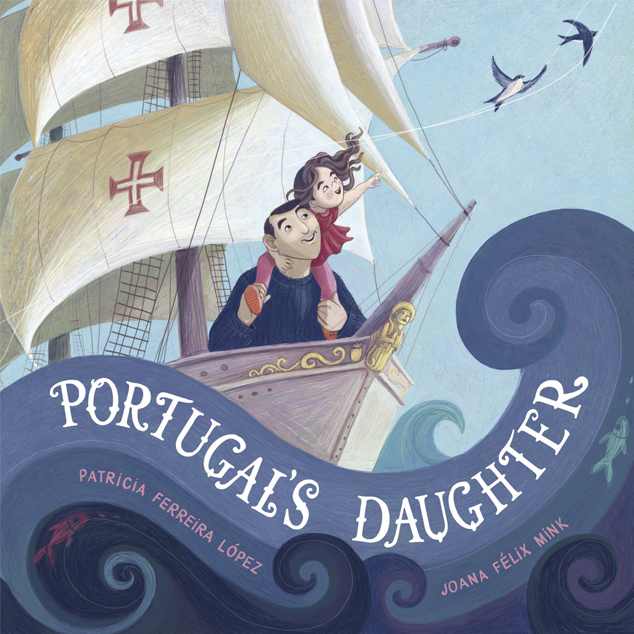
Here we find Papa and his daughter ready to embark on their new adventure. They are sailing on a ship called ‘The Sagres’ is a tall ship and a school-ship of the Portuguese Navy used in the training of their future naval officers. It has become an iconic symbol of Portugal known by her white sails emblazoned with red crosses built in 1937.
1. Title Page

On the title page, you will find the book’s mascot, which is the swallow. (andorinha)
You will often see ceramic swallows in traditional decor and as souvenirs for travellers.
The first ceramic swallows ever sold were designed in 1891 by a famous Portuguese handcrafter, Bordallo Pinheiro.
As these migratory birds always seek to build their nest in the same place where they previously inhabited, they became a symbol of the family and coming home. That was particularly relevant, given the emigration waves that Portugal went through during the XX century.
They also have a single partner during their entire life, and therefore also stand for love, loyalty and faithfulness. It became common to exchange ceramic swallows between lovers when communication was difficult.
What better creature to represent the immigrant and the longing to return to one’s homeland. You will find swallows on every spread of Portugal’s Daughter.
The title page also has a doll dressed in the traditional Nazaré dress.
Nazaré is famous for its traditionally clad women who — at least according to local lore — wear skirts with seven petticoats (possibly one for each day of the week?)
In the old days, women would wait on the beach for fishermen to sail home. To keep warm in the face of a cold sea wind while staying modestly covered, they would wear several petticoats so they could fold layers over their heads, backs, and legs. Even today, older and more traditional women still wear skirts made bulky by several — though not as many as seven — petticoats. The ensemble is completed with house slippers, an apron (hand-embroidered by the wearer), a woolen cape, head scarf, and flamboyant jewelry, including chunky gold earrings (often passed down from generation to generation).
2. Map Spread
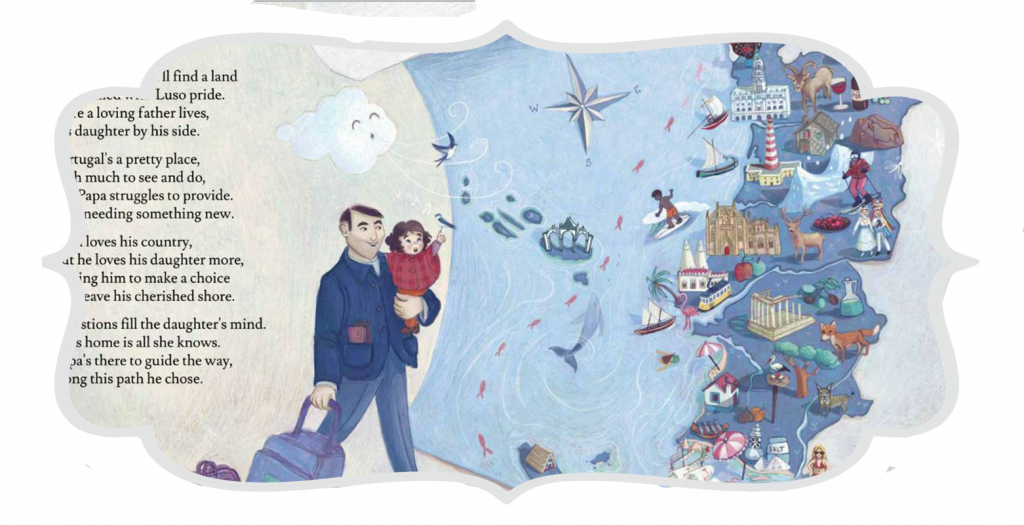
On this first introduction spread, the father and daughter are ready to embark on a new adventure as they face a gorgeous map of Portugal with 40+ land marks and references.
Can you find them all?
These include:
Capital city – The coastal capital city of Portugal is Lisbon. Lisbon is the capital and the largest city of Portugal, with an estimated population of 544,851 within its administrative limits in an area of 100.05 km2.
Galo de Barcelos – The Barcelos Rooster, commonly called the Portuguese Rooster, is said to be the embodiment of the Portuguese love of life. As the unofficial symbol of Portugal, you can find this emblem in many forms in every local shop and especially gift shops. If you would like to read the legend behind it, click here: https://portugalonline.com/portugal-blogs/barcelos-rooster
Castelo de Bragança – The Castle of Bragança is a well-preserved medieval castle located in the historic center of the city of Bragança
– Capa de Honra e Identidade de Miranda do Douro – Honour and Identity Cape worn by only by prominent members of society at special occasions or public events
Vinho do Porto -Port wine- a fortified wine produced in the Douro Valley of northern Portugal. It is typically a sweet red wine, often served with dessert
Cabra Montesa do Gerês – Gerês Mountain Goat
Paços do Concelho, Porto – Porto government building, Neoclassical built in the 1900s featuring a black-marble entrance hall & a clocktower with city views.
Barco Rabelo, Porto – – Wooden cargo boat in Porto
–Casa típica da Beira – Traditional house in Beira
Farol da Barra, Aveiro – Aveiro lighthouse
Barco Moliceiro, Aveiro – traditional colourful boats found in Averio
Arte rupestres, Foz Côa -The Prehistoric Rock-Art Site of the Côa Valley is an open-air Paleolithic archaeological site located in northeastern Portugal.
Serra da Estrela – Serra da Estrela is the highest mountain range in Continental Portugal. ( Also where the author was born!)
Onda da Nazaré – wave in Nazaré, specifically Praia do Norte or North Beach, is home to the biggest surfable waves on the planet.
Mosteiro da Batalha – The Monastery of Batalha is a Dominican convent in the municipality of Batalha, in the district of Leiria, in the Centro Region of Portugal.
Veado, Lousã – Deer in the region of Lousa
Cerejas do Fundão – delicious cherries that are grown in the region of Fundão and sold across the country
Trajes das Festas de Castelo Branco – folk wear from the region of Castelo Branco
Maçãs de Alcobaça – Apples from the region of Alcobaça
Palácio Nacional de Sintra – The castle in Sintra is the best-preserved medieval royal palace in Portugal and was a favourite with the Portuguese nobility
Eléctrico de Lisboa – Quaint yellow tram cars found in Lisbon. The Lisbon tramway network is a system of trams that serve Lisbon, capital city of Portugal. In operation since 1873, it presently comprises six lines. The system has a length of 31 km, and 63 trams in operation.
Palmeira, Cascais – Palm trees in the district of Cascais.
Flamingo, Estuário do Tejo – Flamingos that can be found at the Tagus Estuary Natural Reserve is a natural reserve in Portugal.
Barco Falua, Lisboa – Traditional merchant and passenger ships in Lisbon
Azeite, Alentejo – Olive oil from the Alentejo region that is filled with olive groves.
Templo de Diana, Évora -The Roman Temple of Évora, also referred to as the Templo de Diana is an ancient temple in the Portuguese city of Évora. The temple is part of the historical centre of the city, which was included in the classification by UNESCO as a World Heritage Site.
Raposa Vermelha – The red fox
Sobreiro, árvore da cortiça – The cork tree or the cork oak.
Casa típica do Alentejo – Traditional white and blue houses in the Alentejo region
Cesta do Alentejo – A basket weaved and sold in the Alentejo region
Cegonha – the stork
Figo e laranja do Algarve – Figs and oranges from the south of Portugal, the Algarve region.
Praias do Algarve– The Algarve is famously known for its stunning sandy beaches and costal towns.
Lince Ibérico, Vale do Guadiana – Iberian Linx in the Guadiana Valley Natural , a natural park in southeastern Portugal.
Sardinhas – sardines are a common Portuguese dish usually served with potatoes and local greens.
Chaminé do Algarve – Chimneys in the Algarve, often elaborate and unique in design.
Salinas de Tavira – A region that produces and stores sea salt
Caravela Portuguesa -The Portuguese man o’ war, also known as the man-of-war, is a marine hydrozoan found in the Atlantic Ocean and the Indian Ocean.
Casa típica da Madeira – These small, triangular and colorful houses represent a part of the Madeira’s heritage and one of the most popular tourist attractions
Portas da Cidade, Ponta Delgada, São Miguel, Açores – Iconic 18th-century gates featuring ornate archways in a charming, illuminated public square
Baleia Azul, Açores – The Azores islands are known for being one of Europe’s best destinations for blue whale watching as well as ocean wildlife.
3. The Airplane Spread
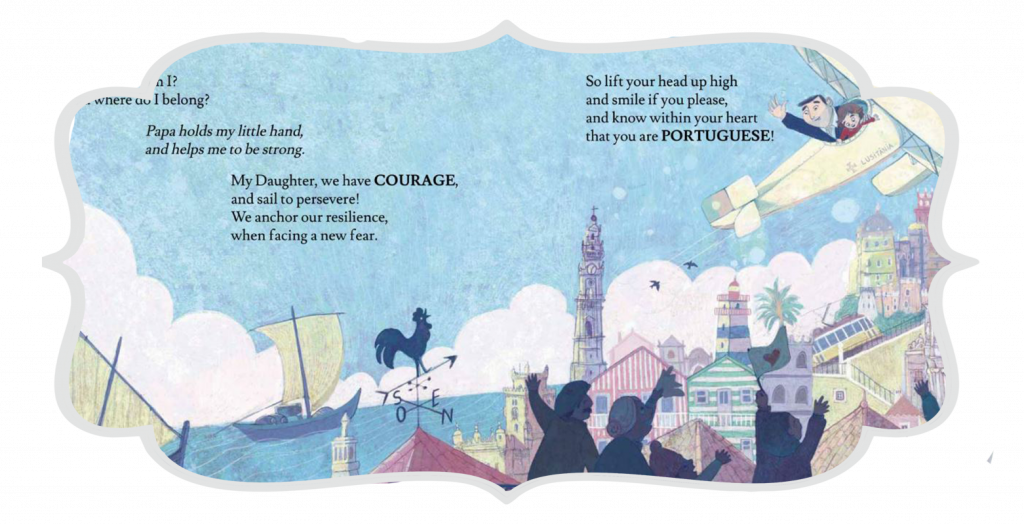
Here you find the father and daughter departing in the seaplane Lusitânia (the first plane to cross the South Atlantic, piloted by Sacadura Cabral and Gago Coutinho). Family members say goodbye from the parapet of the viewpoint of São Pedro de Alcantara, Lisbon.
The city is built with elements from different locations. From Porto, you will see a Rabelo (typical boat), Torre dos Clérigos and the D. Luís bridge. From Lisbon, a Falua (typical boat), Arco da Rua Augusta, Torre de Belém, the tram. From Sintra, the Pena Palace. From Cascais, the Farol da Guia. From Aveiro, the houses of Costa Nova. From Algarve, the chimney and three Telhados Tesoura de Tavira. You can also see a typical Portuguese street lamp and weathervane.
4. The Village Spread

Here the imagery merges from an old world Portuguese village to a modern North American skyline. In the village, you will find a pavour laying cobblestone on a cobblestone street. A water woman getting water from her local fresh water fountain. An old Lisbon kiosk, traditional architecture, and common street animals such as cats and dogs.
5. The ESL spread
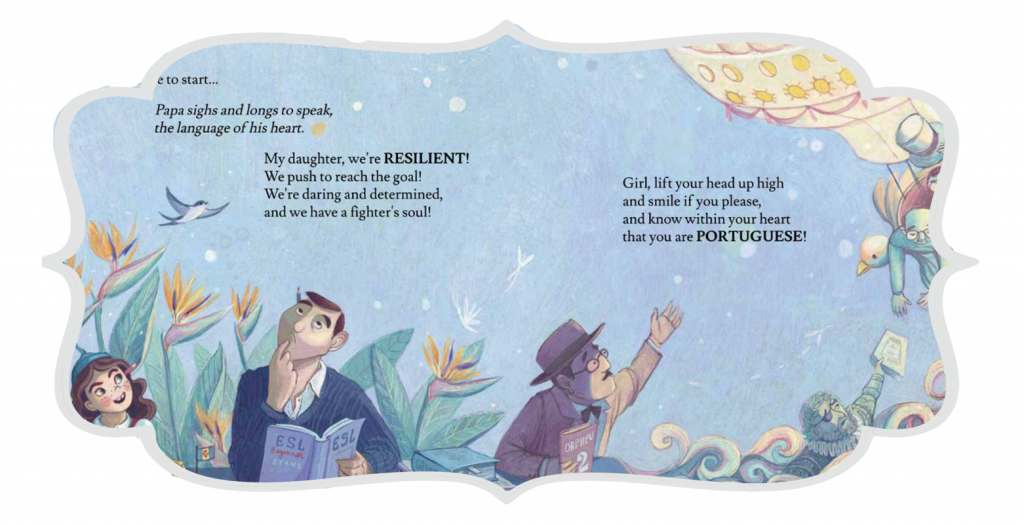
The writers represented are Fernando Pessoa, Camões, Saramago and Eça de Queiroz.
The representation by Fernando Pessoa makes reference to the painting by Almada Negreiros, and the writer holds the Orpheu magazine.
Camões is represented in the famous scene in which he saves the Lusíadas after a shipwreck.
Saramago and Eça travel on Bartolomeu de Gusmão’s Passarola, reinvented by Saramago in the book Memorial do Convento. The seven suns and seven moons refer to the characters in the book, Baltasar and Blimunda.
Father and daughter study English, with ESL books, dictionaries, etc.
The daughter wears a Madeira costume and there’s Madeira traditional elements over the table.
6. The Fishermen Spread
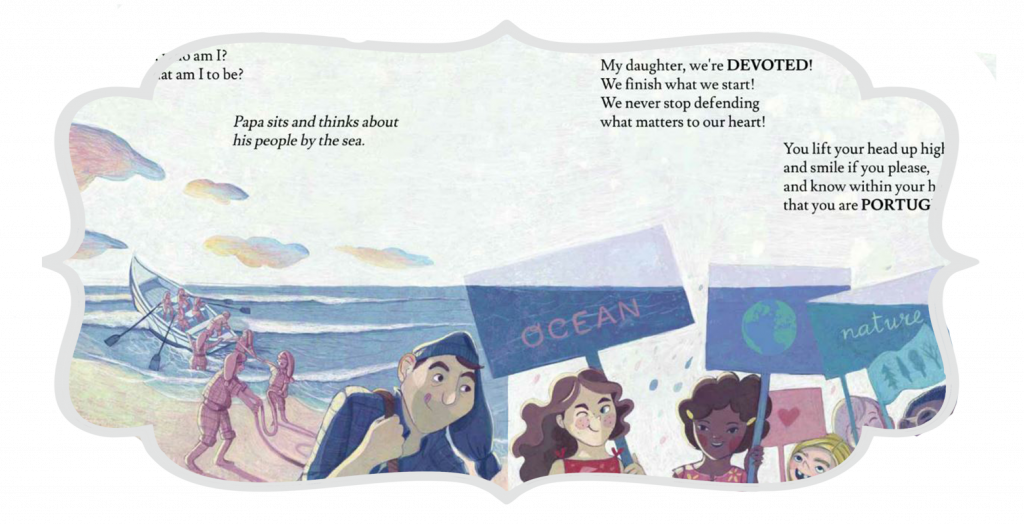
Here we find the father in a traditional fisherman’s hat. We see a varina which is what was called from a woman from the region of Nazare with the seven dresses that were mentioned above.
7. The Hearts Spread
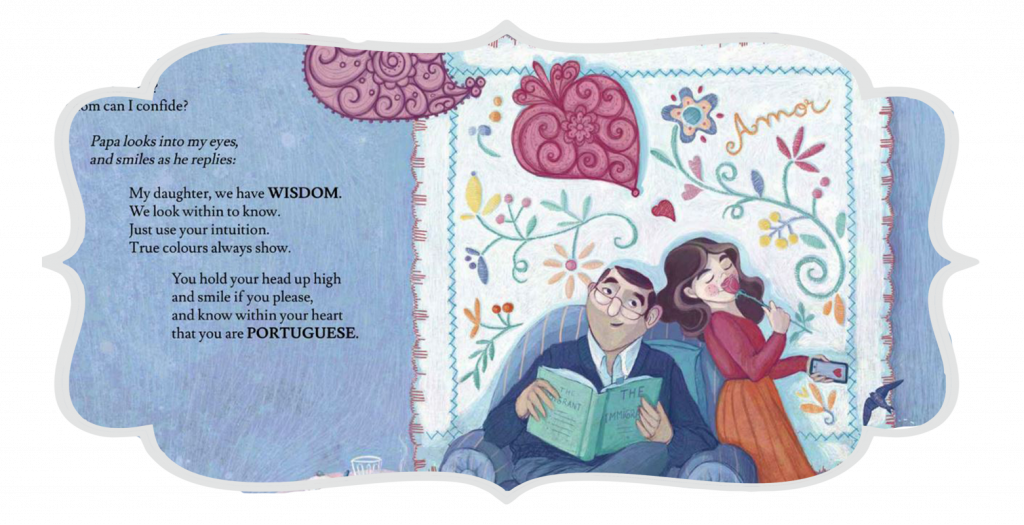
Here you will see our daughter is a teenager and as she is contemplating love and life, her and papa are positioned before an embroidered handkerchief called a ‘lenço dos namorados’ ( A sweetheart’s handkerchief or fiancees) from Minho. It was usually made of linen or cotton and verses and images would be woven into the cloth as a symbol of love and friendship. On the table you will find a ‘Bica’ which is a nickname for coffee in the Lisbon region. You will also see regional sweets from the Algarve.
8. The Graduation Spread
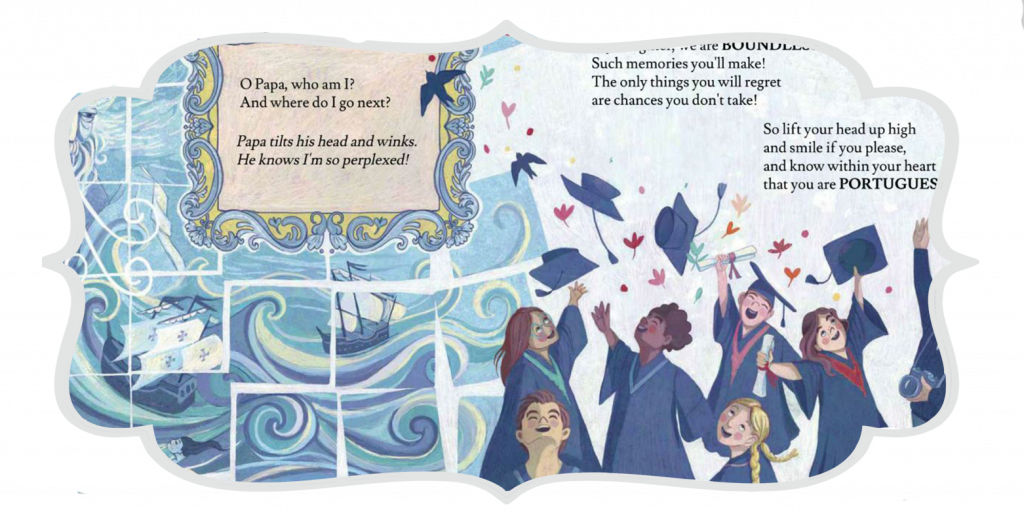
Here as the daughter and father celebrate graduation and a new beginning, you will find the traditional and famous Portuguese blue tiles -(azulejos) found in architecture around the country. On them you will see the nymphs of the Tejo River as well as the famous mythological character named Adamaster who was created by the famous Portuguese poet Luís de Camões in his epic poem Os Lusíadas.
9. The Fado Spread

On this spread, you will see Amelia Rodrigues, a Portuguese singer and actress, who was known as ‘the Queen of Fado.’ She was instrumental in popularizing Portuguese fado music worldwide. The father is playing a Portuguese mandolin. You also see Carnation flowers. These flowers are a nod to the Carnation Revolution. This was an almost bloodless military coup that took place on April 25,1974 ( now a national holiday) ending facism and dictatorship in Portugal. The Carnation Revolution got its name from the fact that almost no shots were fired and from restaurant worker Celeste Caeiro offering carnations to the soldiers when the population took to the streets to celebrate the end of the dictatorship, with other demonstrators following suit and carnations placed in the muzzles of guns and on the soldiers’ uniforms.
10. The Wedding Spread
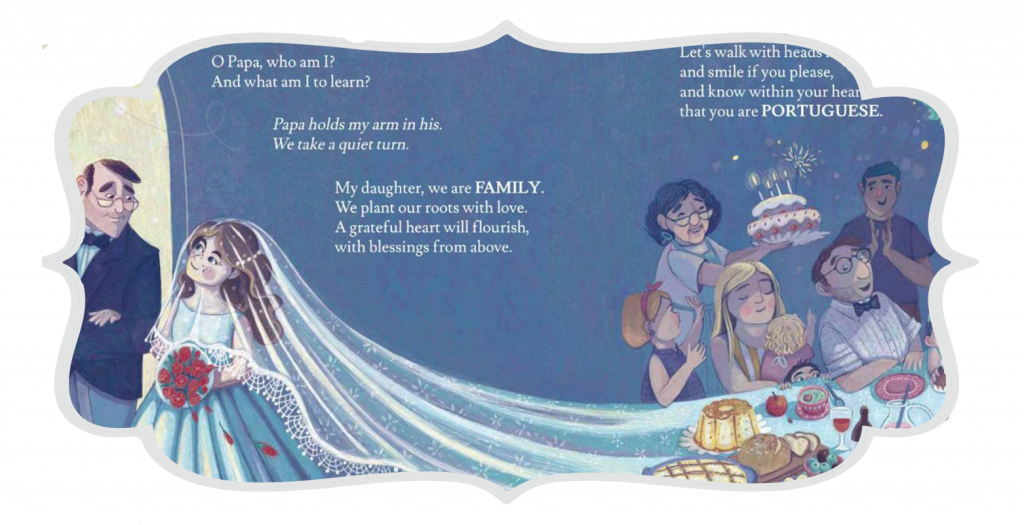
On this gorgeous wedding spread, along with all the Portuguese relatives, you will find many traditional and delicious foods. They include:
Renda de Bilros,
Pastéis de Belém -custard tarts from Belem
Pirámides de chocolate – chocolate pyramids
Vinho do Porto– port wine
Pudim flan– flan pudding
Arroz doce – rice pudding
Queijo da Serra da Estrela -cheese from Serra da Estrela
Loiça das Caldas da Rainha – traditional dishware including a cabbage soup tureen from Bordallo Pinheiro -region of Caldas da Rainha
Sopa caldo verde – green soup,
Pão alentejano, – bread from Alentejo
Sardinhas – sardines.
The bride is also wearing a veil that is made of ‘Renda de Bilros’ which is a beautiful and intricate bobbin lace. It is incredibly detailed and delicate.
11. The Azores Spread
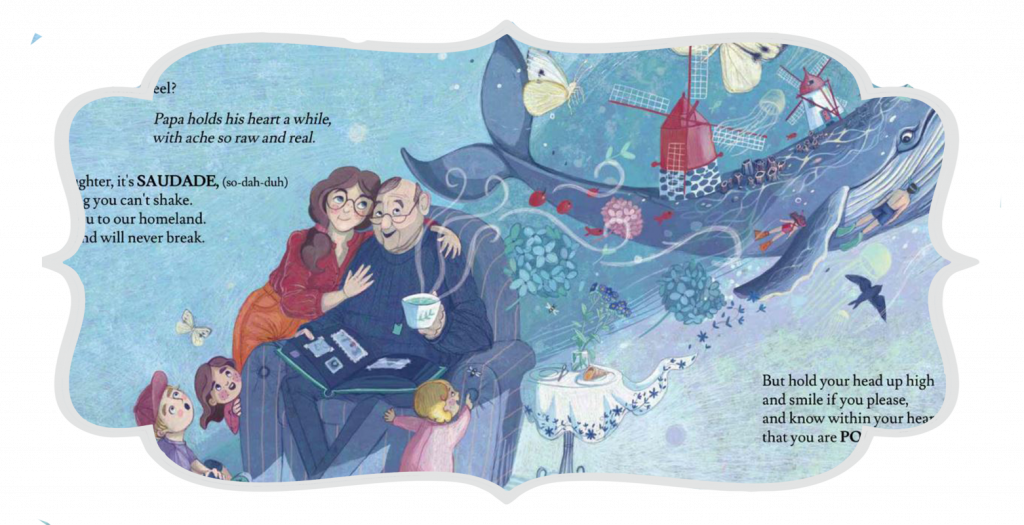
This spread teaches the reader a word that is often used in Portuguese but has no direct English translation. The definition can be found in the immigrant letter from the author. It is ‘saudade’ which is a deep, sometimes melancholy longing for someone or something long ago or far away. It is a sweet reverie of something beautiful your soul cannot forget.
This spread also highlights all the beauty of the Azores islands. Here you will find:
Azorean cabbage butterfly (Pieris brassicae azorensis) Subspecies endemic of Azores.
Snail (Napaeus delibutus) Endemic species that lives in the central group of islands.
Hortenses (or Hydrangea ), these lush blooms found all over the islands in bushes of blue, pink, purple and white.
Não Me Esqueças (Forget me not), a very rare flower that only exists on two islands (Flores and Pico) and nowhere else in the world.
Chá Gorreana, the oldest and only tea plantation in Europe.
Sweet Cornucópia, typical of the Azores.
Embroidery from the Azores.
Three typical wind mills.
Azorean Barnacles (Megabalanus azoricus) Endemic to the Azores and Madeira.
12. The Legacy Spread
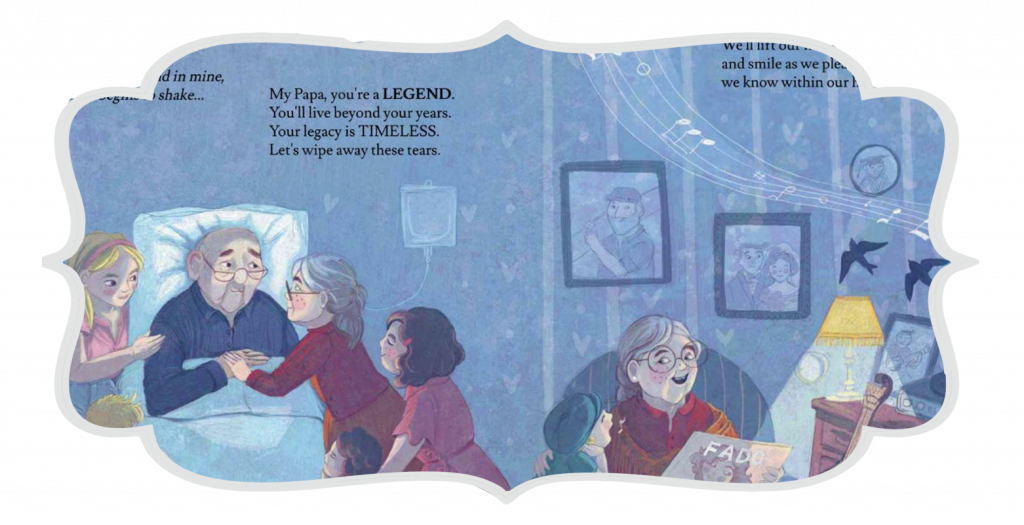
Here as the father is in his final days, we see the daughter already a grandmother herself affirming her precious papa. The room is filled with children and grandchildren. You will find a Portuguese guitar as well as a Fado record.
Filha De Portugal Spread (An adaptation of the book in Portuguese)
13. Filha De Portugal Spread
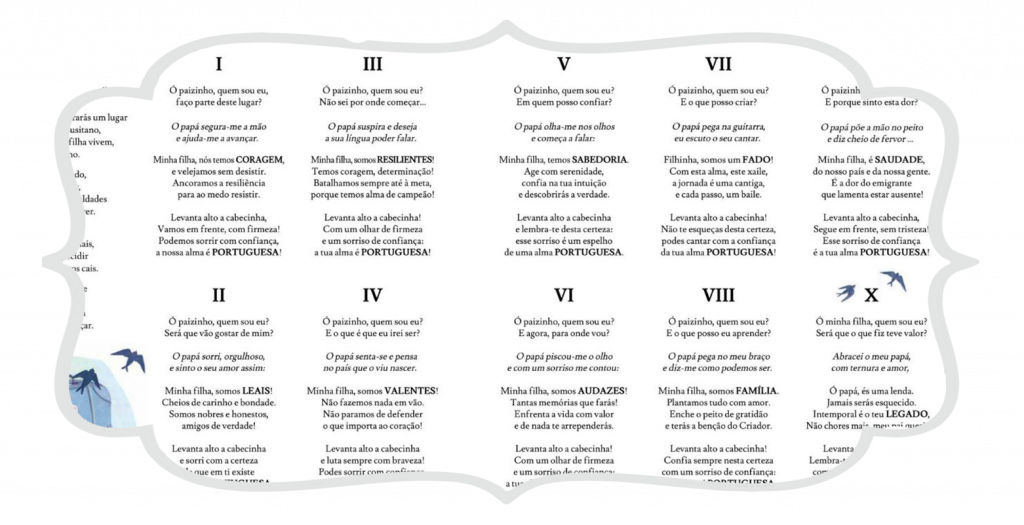
(An adaptation of the book in Portuguese)
This spread is laid out like a Portuguese sonnet with roman numerals.
The entire book has been adapted into the Portuguese language and done in rhyme.
It is not a direct translation, as it is extremely difficult to translate rhyming English verse and not lose the essence of the poem, so we opted for an adaptation that could stand on its own but still capture what was conveyed in the original.
The hope and plan is that a Portuguese illustrated version will be printed and launched in 2023.
14. Find and Seek
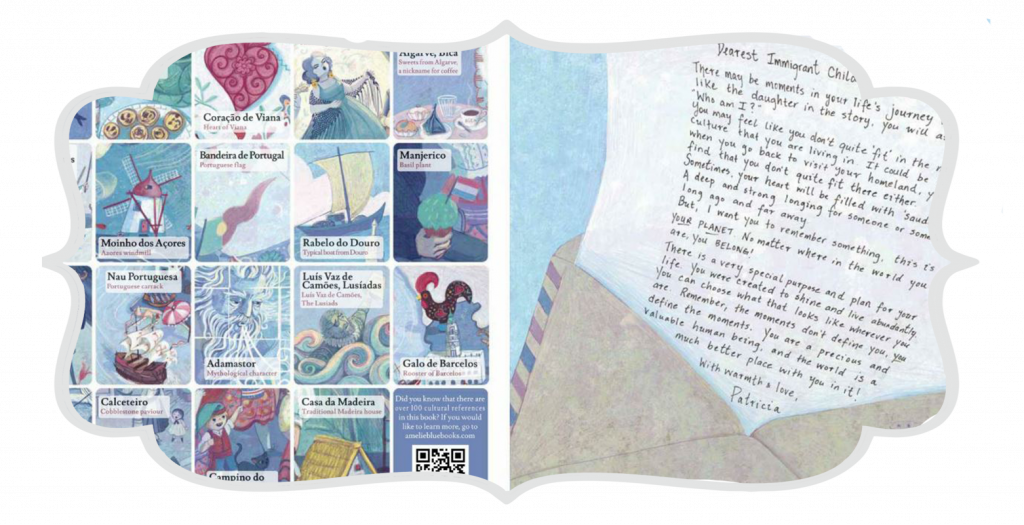
(Immigrant Letter Spread)
In this spread, you will see a FIND AND SEEK page for young readers to go exploring as well as a letter to the immigrant child.
In it you will find the definition for the word ‘saudade’ which appears in the Azores spread.
It does not translate to the English and is stronger than just saying that you miss something or someone. ‘Saudade’ is a deep, intense, and sometimes melancholy longing for someone or something long ago or far away. It is a sweet reverie of something beautiful your soul cannot forget. It is also the underlying theme throughout the whole book. You will notice that the colours are all done in blues and any alluding to the past is always in soft hues of muted pinks, blues and greens.
This book was created in celebration and respect to those Portuguese immigrants around the globe, who often go by unnoticed. Yet, if you should spend some time with one you will often find that their cultural identity, heritage and stories run deep within their veins and they carry their roots as a proud, kind, hardworking and noble people. It has been an incredible privilege and an honour to highlight their story, and may this little book be passed on with warmth and pride to many Portuguese generations to come.
